NHS4000: Health Disparities in US - Annotated Bibliography
VerifiedAdded on 2023/06/15
|8
|1969
|350
Annotated Bibliography
AI Summary
This annotated bibliography examines health disparities in the United States, focusing on differences in health status across various social groups, including race, ethnicity, socioeconomic status, and sexual orientation. The selected articles explore the persistence of these disparities despite efforts like the Affordable Care Act, highlighting barriers to access, financial constraints, and the impact of social determinants. The bibliography also covers potential strategies for reducing health inequalities, such as innovative service delivery, workforce training, and the use of technology. The findings suggest that minorities experience delays in care and a higher prevalence of disorders due to race, ethnicity, and sexual orientation.

Running head: HEALTH DISPARITIES IN UNITED STATES
Eliminating Barriers to Access
Chanelle Ranglin
Capella University
NHS4000
Applying Library Research Skills
February 21, 2018
Eliminating Barriers to Access
Chanelle Ranglin
Capella University
NHS4000
Applying Library Research Skills
February 21, 2018
Paraphrase This Document
Need a fresh take? Get an instant paraphrase of this document with our AI Paraphraser

1HEALTH DISPARITIES IN UNITED STATES
Abstract
In our world today, one of the biggest issues that have risen amongst health care activist in the
United States is how health disparity and inequality has affected rural areas and culture.
However, it is important to keep in the back of our minds that it does not prevail in U.S. rather a
worldwide concern. Health disparity is taking an in depth look at the differences in health status
between different social groups, gender, race, ethnicity, education, income, disability, and sexual
orientation. While on the other hand, health inequalities are looking at the unjust and unfair
treatment one gets because of their socioeconomic status and demographic area in which they are
part of. One of my main reasons for selecting this topic was because I wanted to take an in depth
look through research and studies to find out why health inequality and disparity still exists in a
great and rich country like the United States. In addition, how equality in health care can be
achieved.
Abstract
In our world today, one of the biggest issues that have risen amongst health care activist in the
United States is how health disparity and inequality has affected rural areas and culture.
However, it is important to keep in the back of our minds that it does not prevail in U.S. rather a
worldwide concern. Health disparity is taking an in depth look at the differences in health status
between different social groups, gender, race, ethnicity, education, income, disability, and sexual
orientation. While on the other hand, health inequalities are looking at the unjust and unfair
treatment one gets because of their socioeconomic status and demographic area in which they are
part of. One of my main reasons for selecting this topic was because I wanted to take an in depth
look through research and studies to find out why health inequality and disparity still exists in a
great and rich country like the United States. In addition, how equality in health care can be
achieved.
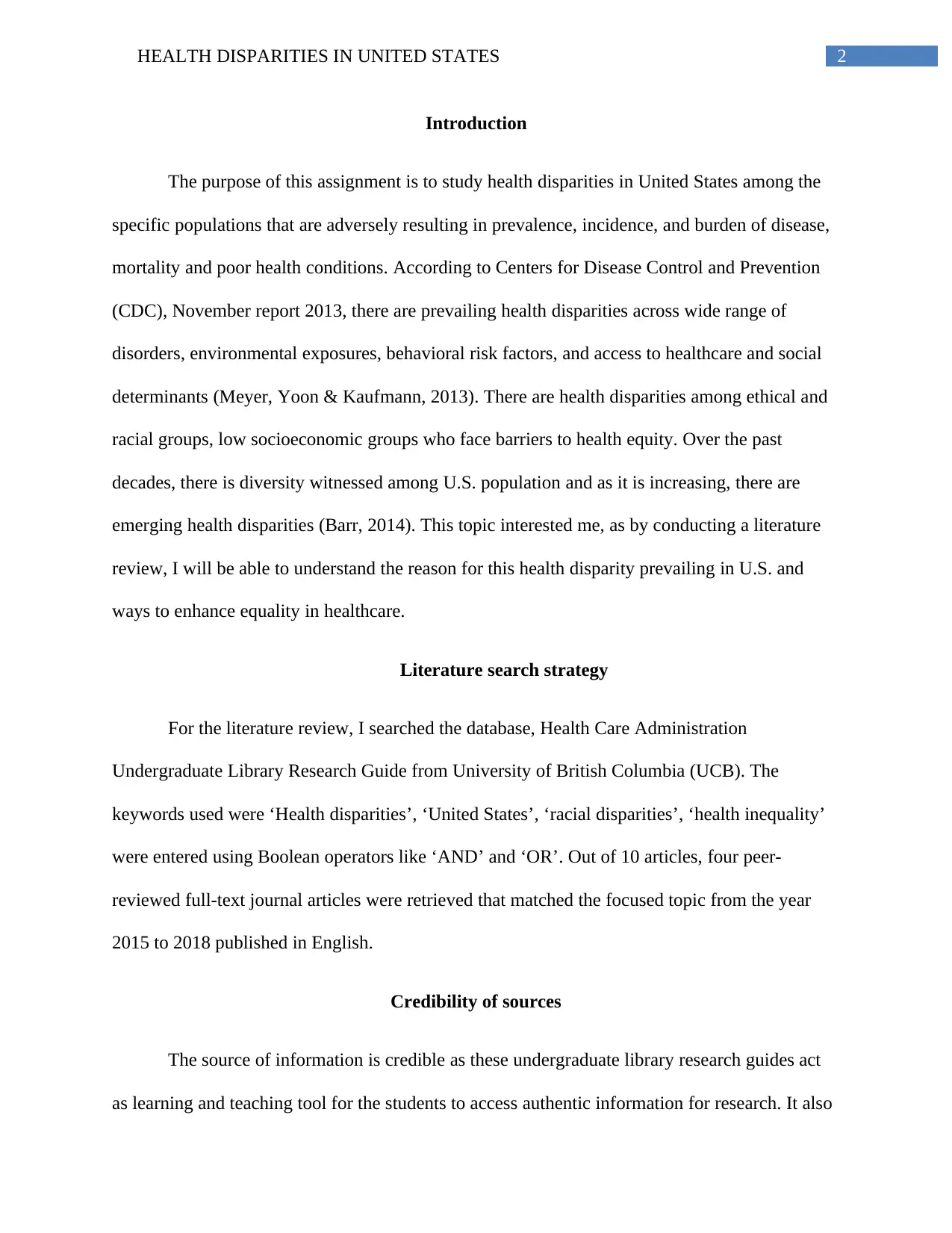
2HEALTH DISPARITIES IN UNITED STATES
Introduction
The purpose of this assignment is to study health disparities in United States among the
specific populations that are adversely resulting in prevalence, incidence, and burden of disease,
mortality and poor health conditions. According to Centers for Disease Control and Prevention
(CDC), November report 2013, there are prevailing health disparities across wide range of
disorders, environmental exposures, behavioral risk factors, and access to healthcare and social
determinants (Meyer, Yoon & Kaufmann, 2013). There are health disparities among ethical and
racial groups, low socioeconomic groups who face barriers to health equity. Over the past
decades, there is diversity witnessed among U.S. population and as it is increasing, there are
emerging health disparities (Barr, 2014). This topic interested me, as by conducting a literature
review, I will be able to understand the reason for this health disparity prevailing in U.S. and
ways to enhance equality in healthcare.
Literature search strategy
For the literature review, I searched the database, Health Care Administration
Undergraduate Library Research Guide from University of British Columbia (UCB). The
keywords used were ‘Health disparities’, ‘United States’, ‘racial disparities’, ‘health inequality’
were entered using Boolean operators like ‘AND’ and ‘OR’. Out of 10 articles, four peer-
reviewed full-text journal articles were retrieved that matched the focused topic from the year
2015 to 2018 published in English.
Credibility of sources
The source of information is credible as these undergraduate library research guides act
as learning and teaching tool for the students to access authentic information for research. It also
Introduction
The purpose of this assignment is to study health disparities in United States among the
specific populations that are adversely resulting in prevalence, incidence, and burden of disease,
mortality and poor health conditions. According to Centers for Disease Control and Prevention
(CDC), November report 2013, there are prevailing health disparities across wide range of
disorders, environmental exposures, behavioral risk factors, and access to healthcare and social
determinants (Meyer, Yoon & Kaufmann, 2013). There are health disparities among ethical and
racial groups, low socioeconomic groups who face barriers to health equity. Over the past
decades, there is diversity witnessed among U.S. population and as it is increasing, there are
emerging health disparities (Barr, 2014). This topic interested me, as by conducting a literature
review, I will be able to understand the reason for this health disparity prevailing in U.S. and
ways to enhance equality in healthcare.
Literature search strategy
For the literature review, I searched the database, Health Care Administration
Undergraduate Library Research Guide from University of British Columbia (UCB). The
keywords used were ‘Health disparities’, ‘United States’, ‘racial disparities’, ‘health inequality’
were entered using Boolean operators like ‘AND’ and ‘OR’. Out of 10 articles, four peer-
reviewed full-text journal articles were retrieved that matched the focused topic from the year
2015 to 2018 published in English.
Credibility of sources
The source of information is credible as these undergraduate library research guides act
as learning and teaching tool for the students to access authentic information for research. It also
⊘ This is a preview!⊘
Do you want full access?
Subscribe today to unlock all pages.

Trusted by 1+ million students worldwide
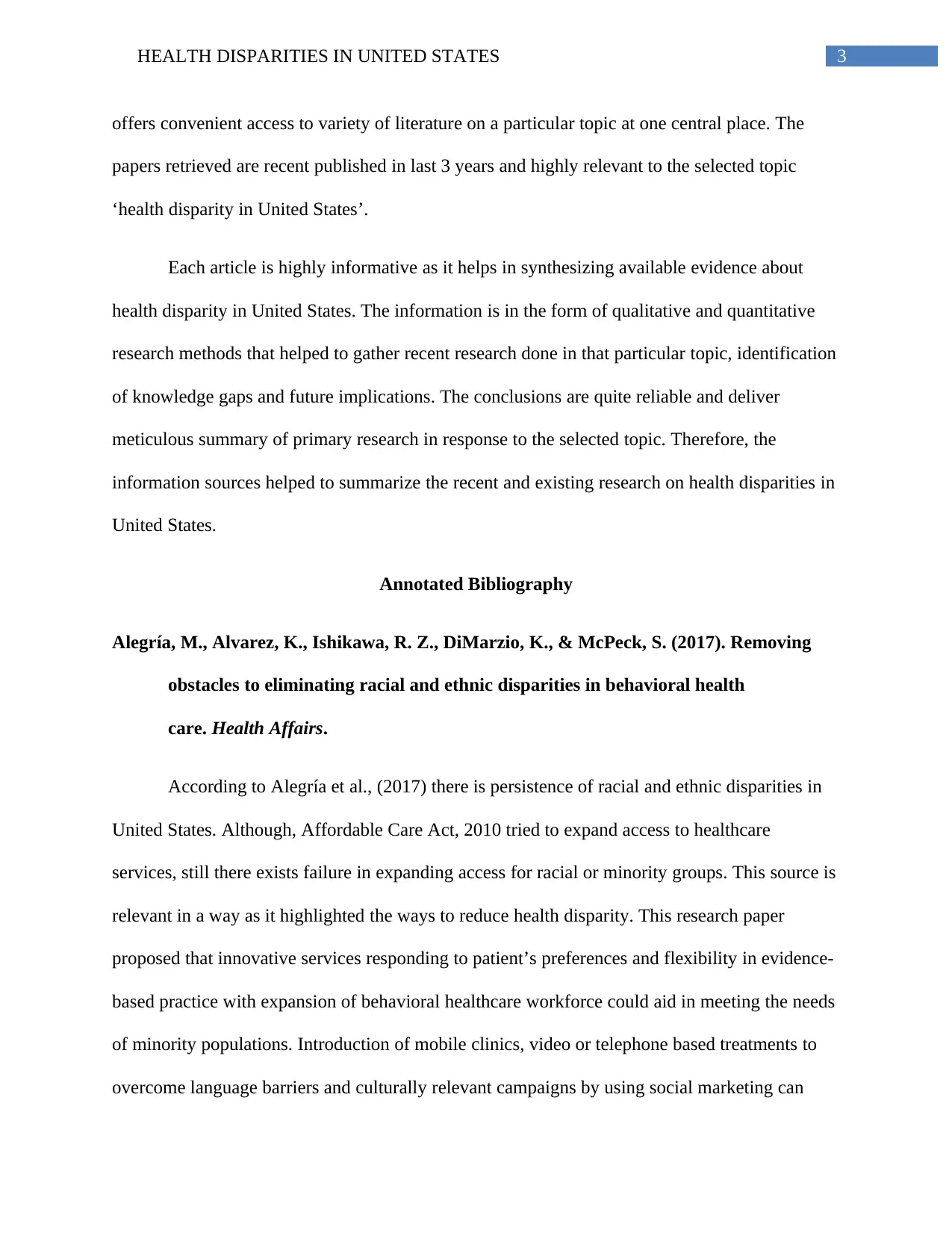
3HEALTH DISPARITIES IN UNITED STATES
offers convenient access to variety of literature on a particular topic at one central place. The
papers retrieved are recent published in last 3 years and highly relevant to the selected topic
‘health disparity in United States’.
Each article is highly informative as it helps in synthesizing available evidence about
health disparity in United States. The information is in the form of qualitative and quantitative
research methods that helped to gather recent research done in that particular topic, identification
of knowledge gaps and future implications. The conclusions are quite reliable and deliver
meticulous summary of primary research in response to the selected topic. Therefore, the
information sources helped to summarize the recent and existing research on health disparities in
United States.
Annotated Bibliography
Alegría, M., Alvarez, K., Ishikawa, R. Z., DiMarzio, K., & McPeck, S. (2017). Removing
obstacles to eliminating racial and ethnic disparities in behavioral health
care. Health Affairs.
According to Alegría et al., (2017) there is persistence of racial and ethnic disparities in
United States. Although, Affordable Care Act, 2010 tried to expand access to healthcare
services, still there exists failure in expanding access for racial or minority groups. This source is
relevant in a way as it highlighted the ways to reduce health disparity. This research paper
proposed that innovative services responding to patient’s preferences and flexibility in evidence-
based practice with expansion of behavioral healthcare workforce could aid in meeting the needs
of minority populations. Introduction of mobile clinics, video or telephone based treatments to
overcome language barriers and culturally relevant campaigns by using social marketing can
offers convenient access to variety of literature on a particular topic at one central place. The
papers retrieved are recent published in last 3 years and highly relevant to the selected topic
‘health disparity in United States’.
Each article is highly informative as it helps in synthesizing available evidence about
health disparity in United States. The information is in the form of qualitative and quantitative
research methods that helped to gather recent research done in that particular topic, identification
of knowledge gaps and future implications. The conclusions are quite reliable and deliver
meticulous summary of primary research in response to the selected topic. Therefore, the
information sources helped to summarize the recent and existing research on health disparities in
United States.
Annotated Bibliography
Alegría, M., Alvarez, K., Ishikawa, R. Z., DiMarzio, K., & McPeck, S. (2017). Removing
obstacles to eliminating racial and ethnic disparities in behavioral health
care. Health Affairs.
According to Alegría et al., (2017) there is persistence of racial and ethnic disparities in
United States. Although, Affordable Care Act, 2010 tried to expand access to healthcare
services, still there exists failure in expanding access for racial or minority groups. This source is
relevant in a way as it highlighted the ways to reduce health disparity. This research paper
proposed that innovative services responding to patient’s preferences and flexibility in evidence-
based practice with expansion of behavioral healthcare workforce could aid in meeting the needs
of minority populations. Introduction of mobile clinics, video or telephone based treatments to
overcome language barriers and culturally relevant campaigns by using social marketing can
Paraphrase This Document
Need a fresh take? Get an instant paraphrase of this document with our AI Paraphraser
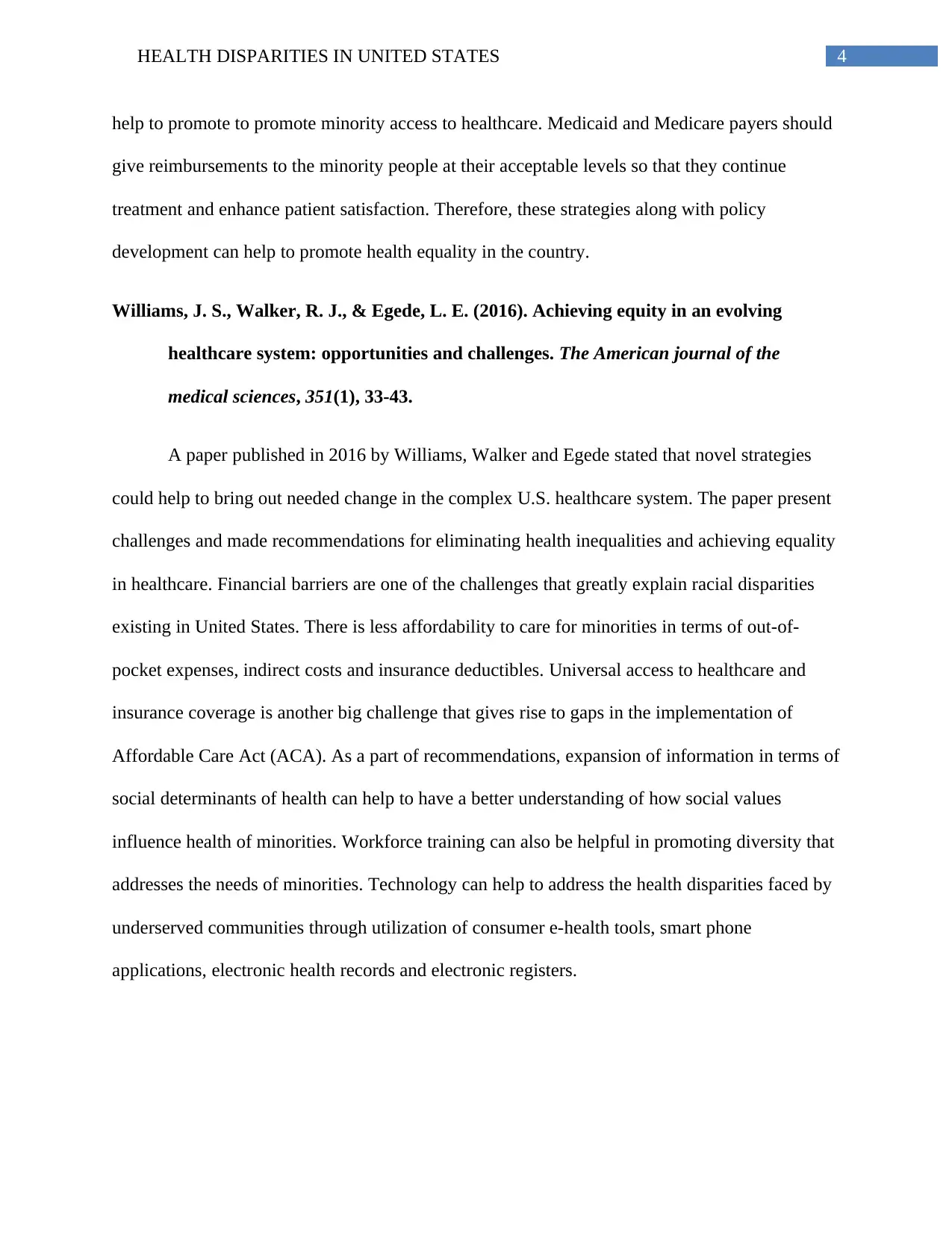
4HEALTH DISPARITIES IN UNITED STATES
help to promote to promote minority access to healthcare. Medicaid and Medicare payers should
give reimbursements to the minority people at their acceptable levels so that they continue
treatment and enhance patient satisfaction. Therefore, these strategies along with policy
development can help to promote health equality in the country.
Williams, J. S., Walker, R. J., & Egede, L. E. (2016). Achieving equity in an evolving
healthcare system: opportunities and challenges. The American journal of the
medical sciences, 351(1), 33-43.
A paper published in 2016 by Williams, Walker and Egede stated that novel strategies
could help to bring out needed change in the complex U.S. healthcare system. The paper present
challenges and made recommendations for eliminating health inequalities and achieving equality
in healthcare. Financial barriers are one of the challenges that greatly explain racial disparities
existing in United States. There is less affordability to care for minorities in terms of out-of-
pocket expenses, indirect costs and insurance deductibles. Universal access to healthcare and
insurance coverage is another big challenge that gives rise to gaps in the implementation of
Affordable Care Act (ACA). As a part of recommendations, expansion of information in terms of
social determinants of health can help to have a better understanding of how social values
influence health of minorities. Workforce training can also be helpful in promoting diversity that
addresses the needs of minorities. Technology can help to address the health disparities faced by
underserved communities through utilization of consumer e-health tools, smart phone
applications, electronic health records and electronic registers.
help to promote to promote minority access to healthcare. Medicaid and Medicare payers should
give reimbursements to the minority people at their acceptable levels so that they continue
treatment and enhance patient satisfaction. Therefore, these strategies along with policy
development can help to promote health equality in the country.
Williams, J. S., Walker, R. J., & Egede, L. E. (2016). Achieving equity in an evolving
healthcare system: opportunities and challenges. The American journal of the
medical sciences, 351(1), 33-43.
A paper published in 2016 by Williams, Walker and Egede stated that novel strategies
could help to bring out needed change in the complex U.S. healthcare system. The paper present
challenges and made recommendations for eliminating health inequalities and achieving equality
in healthcare. Financial barriers are one of the challenges that greatly explain racial disparities
existing in United States. There is less affordability to care for minorities in terms of out-of-
pocket expenses, indirect costs and insurance deductibles. Universal access to healthcare and
insurance coverage is another big challenge that gives rise to gaps in the implementation of
Affordable Care Act (ACA). As a part of recommendations, expansion of information in terms of
social determinants of health can help to have a better understanding of how social values
influence health of minorities. Workforce training can also be helpful in promoting diversity that
addresses the needs of minorities. Technology can help to address the health disparities faced by
underserved communities through utilization of consumer e-health tools, smart phone
applications, electronic health records and electronic registers.
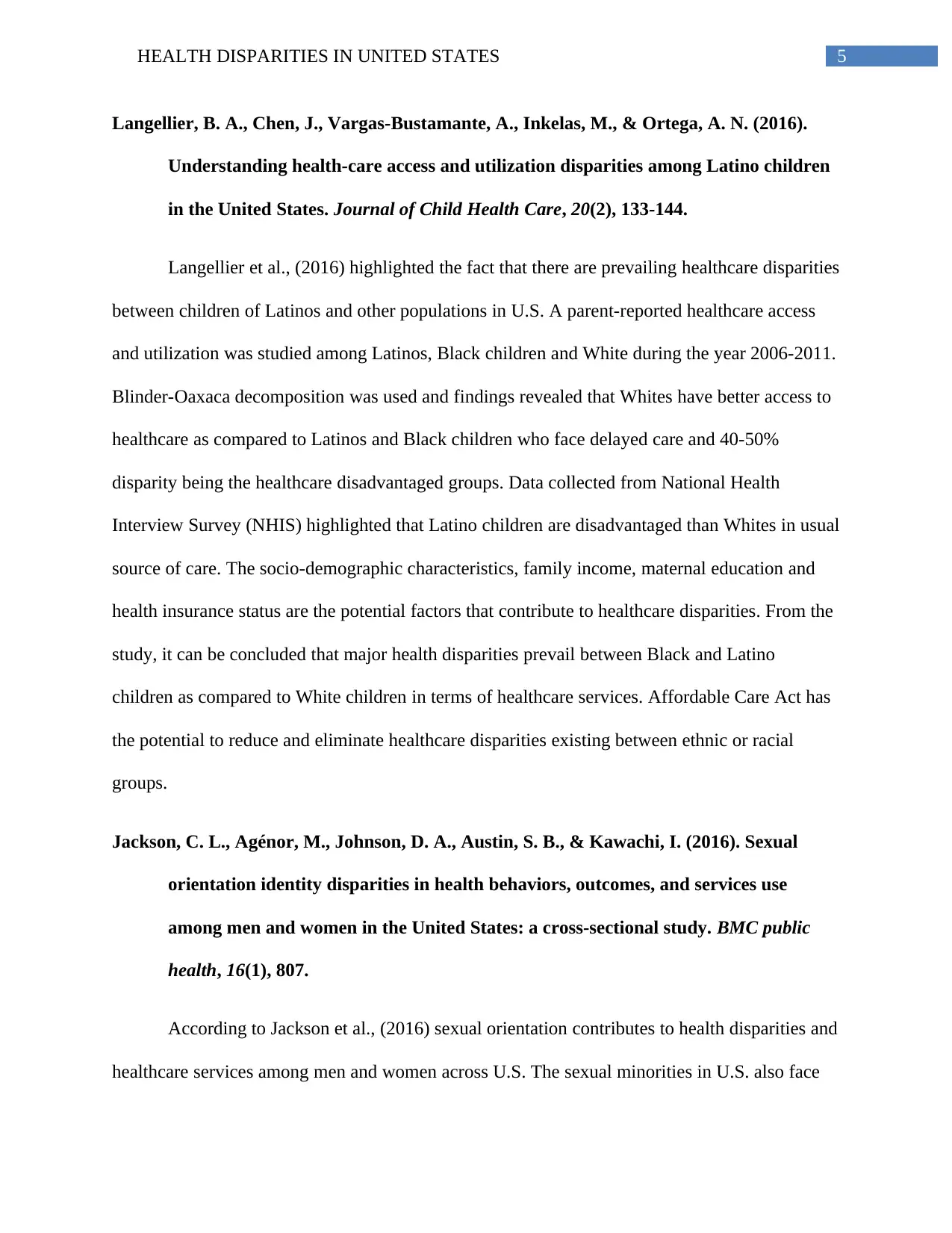
5HEALTH DISPARITIES IN UNITED STATES
Langellier, B. A., Chen, J., Vargas-Bustamante, A., Inkelas, M., & Ortega, A. N. (2016).
Understanding health-care access and utilization disparities among Latino children
in the United States. Journal of Child Health Care, 20(2), 133-144.
Langellier et al., (2016) highlighted the fact that there are prevailing healthcare disparities
between children of Latinos and other populations in U.S. A parent-reported healthcare access
and utilization was studied among Latinos, Black children and White during the year 2006-2011.
Blinder-Oaxaca decomposition was used and findings revealed that Whites have better access to
healthcare as compared to Latinos and Black children who face delayed care and 40-50%
disparity being the healthcare disadvantaged groups. Data collected from National Health
Interview Survey (NHIS) highlighted that Latino children are disadvantaged than Whites in usual
source of care. The socio-demographic characteristics, family income, maternal education and
health insurance status are the potential factors that contribute to healthcare disparities. From the
study, it can be concluded that major health disparities prevail between Black and Latino
children as compared to White children in terms of healthcare services. Affordable Care Act has
the potential to reduce and eliminate healthcare disparities existing between ethnic or racial
groups.
Jackson, C. L., Agénor, M., Johnson, D. A., Austin, S. B., & Kawachi, I. (2016). Sexual
orientation identity disparities in health behaviors, outcomes, and services use
among men and women in the United States: a cross-sectional study. BMC public
health, 16(1), 807.
According to Jackson et al., (2016) sexual orientation contributes to health disparities and
healthcare services among men and women across U.S. The sexual minorities in U.S. also face
Langellier, B. A., Chen, J., Vargas-Bustamante, A., Inkelas, M., & Ortega, A. N. (2016).
Understanding health-care access and utilization disparities among Latino children
in the United States. Journal of Child Health Care, 20(2), 133-144.
Langellier et al., (2016) highlighted the fact that there are prevailing healthcare disparities
between children of Latinos and other populations in U.S. A parent-reported healthcare access
and utilization was studied among Latinos, Black children and White during the year 2006-2011.
Blinder-Oaxaca decomposition was used and findings revealed that Whites have better access to
healthcare as compared to Latinos and Black children who face delayed care and 40-50%
disparity being the healthcare disadvantaged groups. Data collected from National Health
Interview Survey (NHIS) highlighted that Latino children are disadvantaged than Whites in usual
source of care. The socio-demographic characteristics, family income, maternal education and
health insurance status are the potential factors that contribute to healthcare disparities. From the
study, it can be concluded that major health disparities prevail between Black and Latino
children as compared to White children in terms of healthcare services. Affordable Care Act has
the potential to reduce and eliminate healthcare disparities existing between ethnic or racial
groups.
Jackson, C. L., Agénor, M., Johnson, D. A., Austin, S. B., & Kawachi, I. (2016). Sexual
orientation identity disparities in health behaviors, outcomes, and services use
among men and women in the United States: a cross-sectional study. BMC public
health, 16(1), 807.
According to Jackson et al., (2016) sexual orientation contributes to health disparities and
healthcare services among men and women across U.S. The sexual minorities in U.S. also face
⊘ This is a preview!⊘
Do you want full access?
Subscribe today to unlock all pages.

Trusted by 1+ million students worldwide
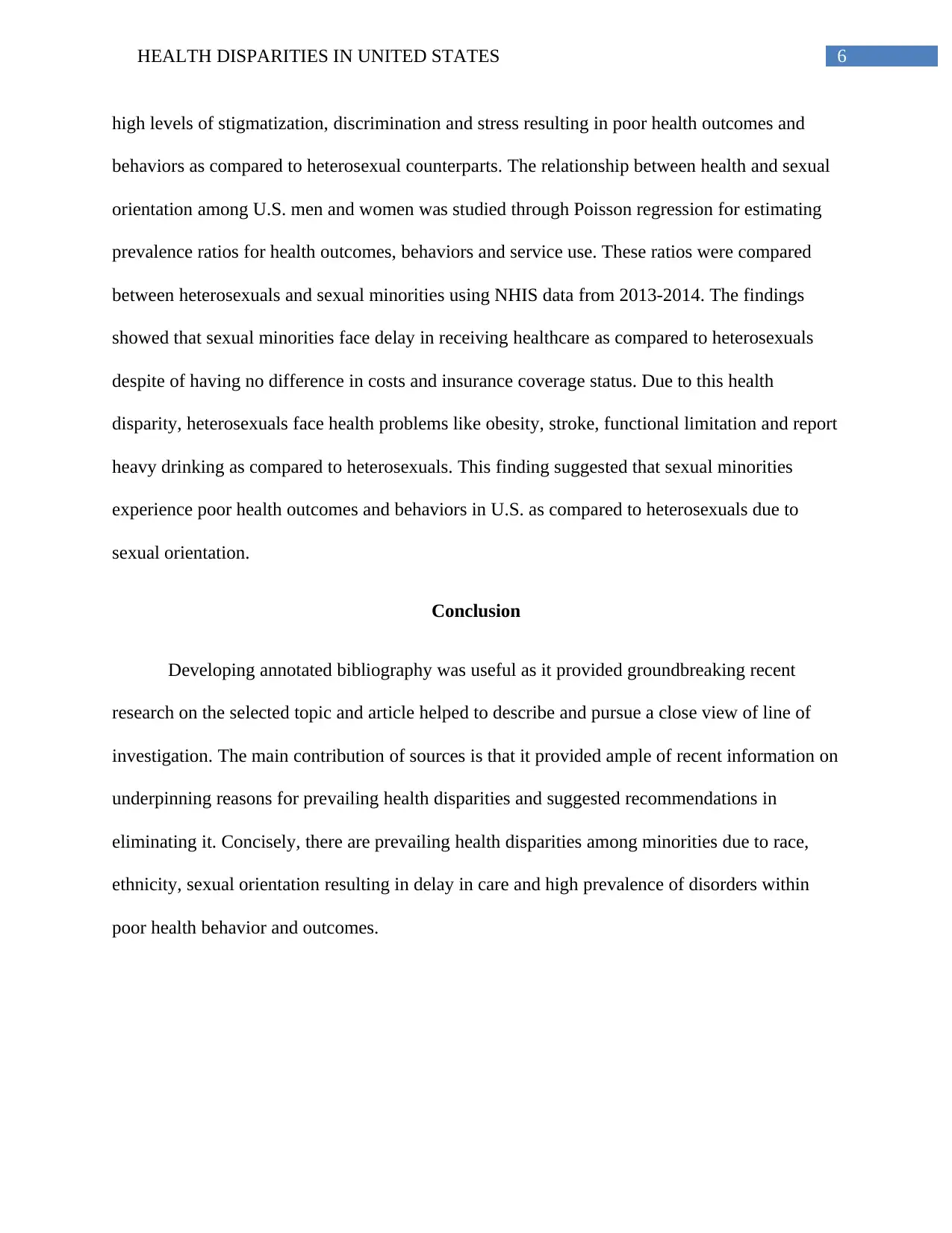
6HEALTH DISPARITIES IN UNITED STATES
high levels of stigmatization, discrimination and stress resulting in poor health outcomes and
behaviors as compared to heterosexual counterparts. The relationship between health and sexual
orientation among U.S. men and women was studied through Poisson regression for estimating
prevalence ratios for health outcomes, behaviors and service use. These ratios were compared
between heterosexuals and sexual minorities using NHIS data from 2013-2014. The findings
showed that sexual minorities face delay in receiving healthcare as compared to heterosexuals
despite of having no difference in costs and insurance coverage status. Due to this health
disparity, heterosexuals face health problems like obesity, stroke, functional limitation and report
heavy drinking as compared to heterosexuals. This finding suggested that sexual minorities
experience poor health outcomes and behaviors in U.S. as compared to heterosexuals due to
sexual orientation.
Conclusion
Developing annotated bibliography was useful as it provided groundbreaking recent
research on the selected topic and article helped to describe and pursue a close view of line of
investigation. The main contribution of sources is that it provided ample of recent information on
underpinning reasons for prevailing health disparities and suggested recommendations in
eliminating it. Concisely, there are prevailing health disparities among minorities due to race,
ethnicity, sexual orientation resulting in delay in care and high prevalence of disorders within
poor health behavior and outcomes.
high levels of stigmatization, discrimination and stress resulting in poor health outcomes and
behaviors as compared to heterosexual counterparts. The relationship between health and sexual
orientation among U.S. men and women was studied through Poisson regression for estimating
prevalence ratios for health outcomes, behaviors and service use. These ratios were compared
between heterosexuals and sexual minorities using NHIS data from 2013-2014. The findings
showed that sexual minorities face delay in receiving healthcare as compared to heterosexuals
despite of having no difference in costs and insurance coverage status. Due to this health
disparity, heterosexuals face health problems like obesity, stroke, functional limitation and report
heavy drinking as compared to heterosexuals. This finding suggested that sexual minorities
experience poor health outcomes and behaviors in U.S. as compared to heterosexuals due to
sexual orientation.
Conclusion
Developing annotated bibliography was useful as it provided groundbreaking recent
research on the selected topic and article helped to describe and pursue a close view of line of
investigation. The main contribution of sources is that it provided ample of recent information on
underpinning reasons for prevailing health disparities and suggested recommendations in
eliminating it. Concisely, there are prevailing health disparities among minorities due to race,
ethnicity, sexual orientation resulting in delay in care and high prevalence of disorders within
poor health behavior and outcomes.
Paraphrase This Document
Need a fresh take? Get an instant paraphrase of this document with our AI Paraphraser
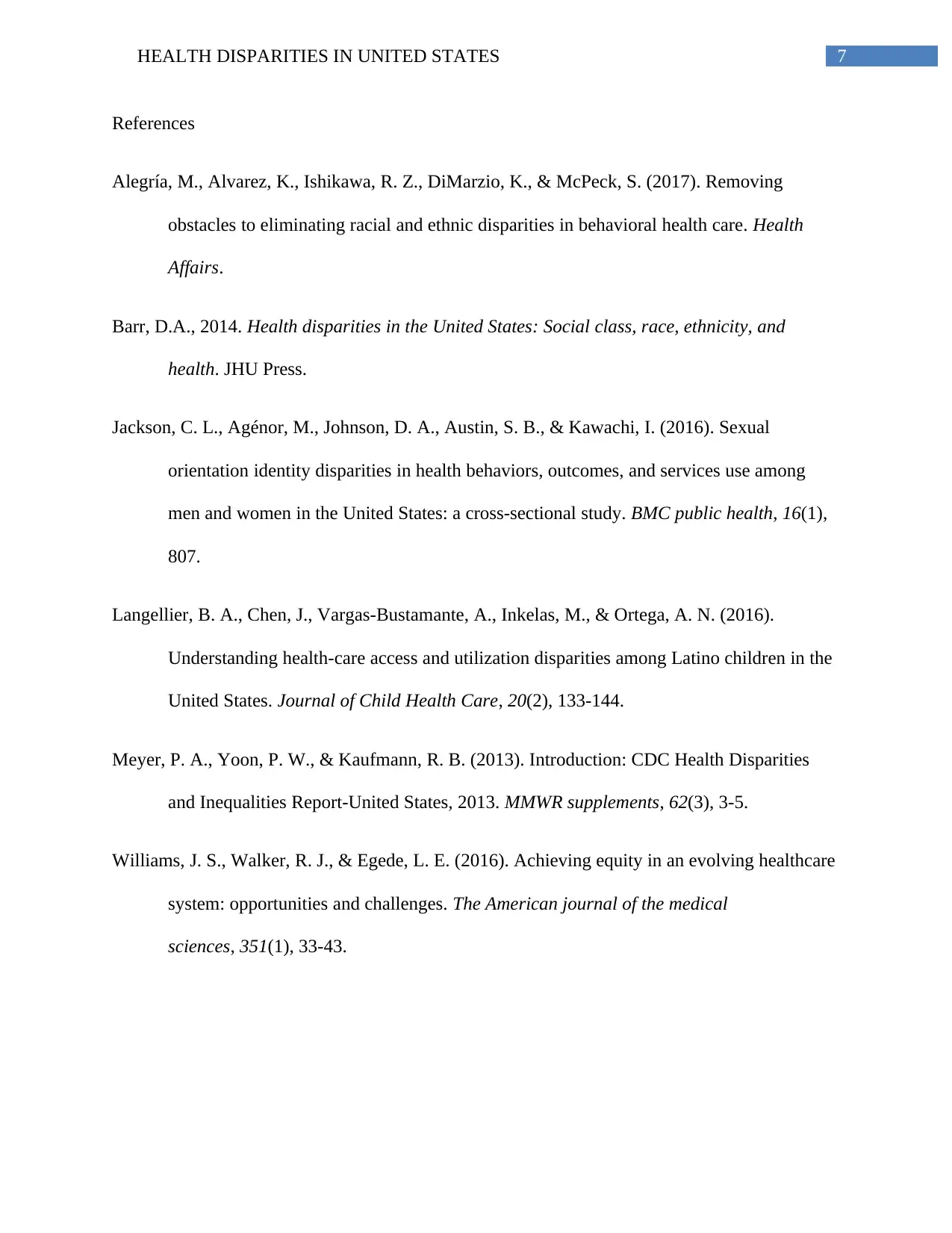
7HEALTH DISPARITIES IN UNITED STATES
References
Alegría, M., Alvarez, K., Ishikawa, R. Z., DiMarzio, K., & McPeck, S. (2017). Removing
obstacles to eliminating racial and ethnic disparities in behavioral health care. Health
Affairs.
Barr, D.A., 2014. Health disparities in the United States: Social class, race, ethnicity, and
health. JHU Press.
Jackson, C. L., Agénor, M., Johnson, D. A., Austin, S. B., & Kawachi, I. (2016). Sexual
orientation identity disparities in health behaviors, outcomes, and services use among
men and women in the United States: a cross-sectional study. BMC public health, 16(1),
807.
Langellier, B. A., Chen, J., Vargas-Bustamante, A., Inkelas, M., & Ortega, A. N. (2016).
Understanding health-care access and utilization disparities among Latino children in the
United States. Journal of Child Health Care, 20(2), 133-144.
Meyer, P. A., Yoon, P. W., & Kaufmann, R. B. (2013). Introduction: CDC Health Disparities
and Inequalities Report-United States, 2013. MMWR supplements, 62(3), 3-5.
Williams, J. S., Walker, R. J., & Egede, L. E. (2016). Achieving equity in an evolving healthcare
system: opportunities and challenges. The American journal of the medical
sciences, 351(1), 33-43.
References
Alegría, M., Alvarez, K., Ishikawa, R. Z., DiMarzio, K., & McPeck, S. (2017). Removing
obstacles to eliminating racial and ethnic disparities in behavioral health care. Health
Affairs.
Barr, D.A., 2014. Health disparities in the United States: Social class, race, ethnicity, and
health. JHU Press.
Jackson, C. L., Agénor, M., Johnson, D. A., Austin, S. B., & Kawachi, I. (2016). Sexual
orientation identity disparities in health behaviors, outcomes, and services use among
men and women in the United States: a cross-sectional study. BMC public health, 16(1),
807.
Langellier, B. A., Chen, J., Vargas-Bustamante, A., Inkelas, M., & Ortega, A. N. (2016).
Understanding health-care access and utilization disparities among Latino children in the
United States. Journal of Child Health Care, 20(2), 133-144.
Meyer, P. A., Yoon, P. W., & Kaufmann, R. B. (2013). Introduction: CDC Health Disparities
and Inequalities Report-United States, 2013. MMWR supplements, 62(3), 3-5.
Williams, J. S., Walker, R. J., & Egede, L. E. (2016). Achieving equity in an evolving healthcare
system: opportunities and challenges. The American journal of the medical
sciences, 351(1), 33-43.
1 out of 8
Related Documents
Your All-in-One AI-Powered Toolkit for Academic Success.
+13062052269
info@desklib.com
Available 24*7 on WhatsApp / Email
![[object Object]](/_next/static/media/star-bottom.7253800d.svg)
Unlock your academic potential
Copyright © 2020–2025 A2Z Services. All Rights Reserved. Developed and managed by ZUCOL.




